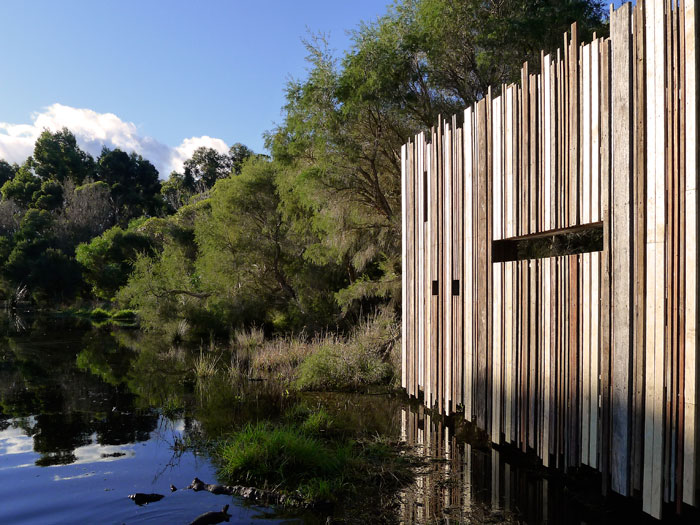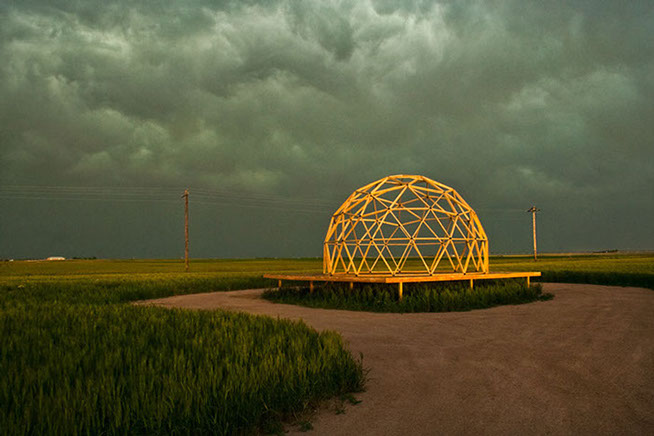Jetsonorama | Painted Desert Project | Arizona
Header image at the top of this page is “Gray Mountain” by Jetsonorama
Image: “Ben” by Jetsonorama
Chip Thomas is an African American street artist known as Jetsonorama. He is an American doctor working on the Navajo Reservation in Arizona as a physician and street artist. Thomas has always been moved by street art, graffiti and old school hip-hop, and bringing this street culture to rural Arizona through his wheat pasted photographic installations has had an influential effect on the local population and traveling passerbys within the reservation. He photographs locals and blows the prints up larger than life to then be wheat pasted onto roadside stands, water tanks and abandoned buildings. The installations depict the Navajo people and their traditions, and Thomas spends a considerable amount of time with people in the community in order to know the people, culture and place and to effectively communicate that culture within his work. The artist is introducing a medium traditionally identified with the urban into the rural, and by doing so, he is exploring traditional and contemporary Navajo culture and life, creating a bridge between then and now.
Type of Installation: Impersonation & Rapprochement
Franconia Sculpture Park | Minnesota
Image: Dyramid by Mike Calway-Fagen
Near a cornfield in rural Chisago County, Minnesota, lives Franconia Sculpture Park, an experimental site for ambitious artists to play in wide open spaces. “Franconia Sculpture Park is a place where emerging and established artists live, create, and exhibit three-dimensional artwork in a singular, prairie-like location. The sky and the land are hallmarks of the Franconia experience, for both artists and visitors.” The artists are literally creating big things here, pushing their own limits as well as the limits of the material, and challenging each other to rise to new heights. Many of the works are derived specifically from the landscape and connected to the location. Artists are highly encouraged to interact with the public, creating an open atmosphere of participation and creation.
Type of Installation: Enchantment
Lynne Hull | Green River Belt Project | Wyoming
Image: Installation from the Green River Belt in Wyoming
Lynne Hull has pioneered “trans-species” art, creating sculpture installations that provide shelter, food, water or space for wildlife, as eco-atonement for their loss of habitat to human encroachment. She works from the belief that artist creativity can be effectively applied to the urgent situations we face today. Her esteemed client list includes hawks, eagles, pine martin, osprey, owls, spider monkeys, salmon, butterflies and many other species. One of Lynne’s projects was a series of habitat sculptures for a walk/bike path along the Green River in Western Wyoming. Many of them catered specifically to the habitat needs of native birds of prey while also adding an additional element of beauty to landscape.The project was a collaboration with the Wyoming Game and Fish Division and the City of Green River, Wyoming.
Type of Installation: Rapprochement
M12 Collective & International Art Space | The Ornitarium | Denmark Shire, Western Australia
The Ornitarium is an architectural installation sculpture constructed at the Wetlands Education Centre just outside of the Shire of Denmark, WA as a bird hide and social space. It was inspired by knowledge of birds, plant-life and nature in the wetlands areas and provides a base for learning about the local ecosystem while providing a barrier between humans and the habitat. The structure directly connects both constructed space, art and environment as well as participants who utilize the space. People become an integral part of the installation by being in the space and using it for learning and research. Visitors are encouraged to leave writings, drawings or checklists of birds they have seen at the site in the project archive, therefore becoming part of the actual installation and contributing the experience of others who come after. The site is a great example of breaking the boundaries of art while also creating a piece that serves an environmental and social purpose.
Type of Installation: Intervention
Derek Grubaugh and Lindsay Kotovsky | Open Space | Colorado
Open Space is a flexible and trans-formative space that attempts to link social and natural environments. The project has been developed to support creative activities and experiential events that focus on people and the rural landscape. Sited in a wheat field in Eastern Colorado, this contemplative environment invites visitors to focus on place and connect with ones sensory experiences of the cycle of farming. The wooden platform was built using the remnants from Yuma County’s original rodeo arena, and is designed to “lift” the 24-foot geodesic dome to the height of a fully-grown stock of wheat. As wheat around the structure matures, the built components seem to gently float on the top of the vast High-Plains landscape.
Type of Installation: Rapprochement
Karl Unnasch | The Ruminant | Harvest Park Project | Wisconsin
Every autumn in Reedsburg, Wisconsin the countryside is dotted with creative art installations made by visiting artists and locals for the ten-day “Farm/Art D Tour.” In 2013, a group of locals were particularly drawn to one sculpture, Ruminant: The Grand Masticator. Artist Karl Unnasch created the sculpture by outfitting a John Deere 6600 combine with 34 original stained glass panels that are illuminated at night. The local group did not want to see this “agricultural cathedral” disappear after ten days, so a committee was formed to raise funds to purchase Ruminant and to keep it in the community for good. The above video is from their Kickstarter campaign which successfully raised enough money to keep the sculpture in the community.
Type of Installation: Enchantment
Maya Lin | Folds in the Field | New Zealand
Notes from Maya Lin lecture at University of Oregon, November 2014.
Maya Lin creates large-scale, monumental works that are incredibly site-specific and are designed to respond perfectly to their environment. Her work is inspired by natural forms from waves, which led her to create her largest earthwork to date, “Folds in the Field,” to topography, waterworks, trees, wildlife and more. “Folds in the Field” is sixty feet high and took her three to four years to complete. It began with smaller scale studies leading up to the massive production of the installation. She utilizes topography and landscape a lot in her work, referring back to science to demonstrate a different way of looking at the world. Lin relies on the existing nature, the existing landscape and the existing stories within a place.
“All I can do as an artist is encourage a different way of thinking. Art can’t necessarily change the world but it can change how you see the world.” –Maya Lin, UO lecture, November 2014
Maya Lin successfully combines her monumental installations with ecological concerns in every facet of her work. Her most recent work is about the sixth extinction. There have been five mass extinctions in the history of the world and the sixth will be caused by humans. We will lose species and we will lose habitats. The question she posed was, “can we as humans share the world?” What is Missing explores the loss of these species and habitats through removing the sounds and presence of certain species. But Lin believes that we must be optimistic as it is the only thing that we can do. She said that “Nature is resilient. If we give it a chance, it will come back.”
Type of Installation: Rapprochement
Resources
Calway-Fagen, M. (2014, Dec. 2). Retrieved from http://www.mikecalway-fagen.com/
Fermentation Fest (2014, Dec. 2) Farm/Art D Tour. Retrieved from http://fermentationfest.com/farmart-dtour-the-land-is-alive
Franconia Sculpture Park. (2014, Dec. 2). Retrieved from http://www.franconia.org/
Grubaugh, D.W. (2014, Dec. 2) Derek Walter Grubaugh. Retrieved from http://derekwalter.net/
Hull, L. (2014, Dec. 2). Creating Trans-Species Art and Sculpture for Wildlife. Retrieved from http://eco-art.org/
Lin, M. (2014, November). Maya Lin: Artist and Designer. Lecture conducted as part of a series from the Oregon Humanities Center, Eugene, Oregon.
Lin, M. (2014, Dec. 2) Maya Lin Studio [website]. Retrieved from http://www.mayalin.com/
Thomas, Chris (2014, Dec. 2) Jetsonorama, Painted Desert Project. Retrieved from http://jetsonorama.net/







